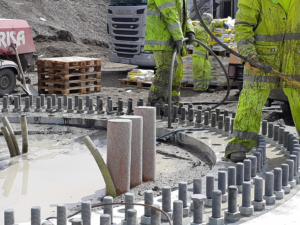The Benefits of Using Williams Anchors for Long-Lasting Structure Protection
The Benefits of Using Williams Anchors for Long-Lasting Structure Protection
Blog Article
Innovative Rock Anchors for Boosted Building Support
Cutting-edge rock anchors have increasingly end up being a focal factor in construction engineering, especially as tasks demand greater stability and efficiency. As we think about the effects of smart sensors and sustainable methods, one must ask: just how will these developments redefine the future of building assistance?
Advancement of Rock Anchors
The evolution of rock anchors has substantially changed building and construction techniques over the past century. Initially, rock anchoring techniques were simple, depending on straightforward mechanical tools and rudimentary materials. As design self-controls advanced, so did the understanding of geological conditions and the demand for trusted securing systems - Williams Anchors. The mid-20th century saw the intro of high-strength steel ligaments, which supplied improved load-bearing capabilities, enabling for more ambitious construction tasks in tough surfaces.
In tandem with improvements in materials science, the growth of grouting methods enhanced the bond between the support and surrounding rock, leading to raised security and sturdiness. The integration of modern technology right into design and screening processes has actually led to much more precise and reliable installation approaches, additionally optimizing efficiency. Computer modeling and simulations currently enable designers to anticipate anchor habits under various problems, enhancing safety and security and reliability.
In addition, the growing focus on sustainability within building techniques has brought about developments in environment-friendly materials and methods for rock anchoring. Overall, the journey of rock supports reflects the building industry's adaptation to both technical developments and the raising complexity of contemporary design challenges.

Sorts Of Modern Rock Anchors
Modern rock anchors can be found in a range of kinds, each created to meet certain engineering needs and geological conditions. One of the most common kinds consist of grouted anchors, which entail inserting a steel ligament into a drilled opening and filling the area with cement to produce a solid bond with the surrounding rock - Williams Anchors. These anchors are often utilized in applications calling for high load capabilities
Another commonly utilized kind is the mechanical support, which relies upon mechanical tools to secure the support in position without the need for grouting. These anchors are preferred in scenarios where prompt load-bearing capability is vital.
Furthermore, there are post-tensioned anchors, which are mounted tensioned to supply stability to frameworks such as bridges and retaining wall surfaces. These supports assist to counteract tensile pressures acting upon the framework.
Advantages of Cutting-edge Layouts
Technology in rock support style brings numerous benefits that enhance building efficiency and architectural integrity. Modern styles use innovative products and design strategies to dramatically boost load-bearing capacities. These innovative anchors are often constructed from high-strength steel or composite materials, which not just minimize weight however additionally boost resistance to deterioration, making sure long life and dependability in various environmental conditions.
Additionally, using computer-aided design (CAD) and finite element evaluation (FEA) permits specific modeling and testing of anchor performance under real-world conditions. This causes anchors that can be tailored to particular task demands, enhancing their performance and minimizing the demand for over-engineering, which can be both cost and resource-intensive.

Study in Construction
Real-world applications of cutting-edge rock anchor designs show their transformative influence on building and construction jobs. One notable situation study involves the construction of a skyscraper in a seismically active area. Engineers employed progressed rock anchoring strategies that made use of high-strength materials, ensuring the framework's security versus potential earthquakes. The supports were tactically placed to enhance lots circulation and lessen settlement, inevitably resulting in an extra resistant structure.
An additional substantial example can be located in the development his comment is here of a transportation tunnel. Cutting-edge rock anchors were made use of to protect the passage wall surfaces, enabling much deeper excavation without jeopardizing safety. The execution of grouted rock anchors used boosted tensile strength, making it possible for employees to progress the why not check here job right away.
In a third instance, a major dam project included rock anchors to maintain the embankment. Using corrosion-resistant materials in the anchors made sure lasting resilience, reducing upkeep expenses and boosting safety and security criteria.
These study demonstrate the efficiency of innovative rock anchor styles in attending to complicated engineering challenges, emphasizing their essential role in modern building methods. The effective end results highlight the requirement for continued financial investment in sophisticated anchoring technologies to fulfill developing building and construction demands.
Future Trends in Rock Anchoring
As building needs evolve, the future of rock anchoring is poised for substantial improvements that will certainly enhance safety and security and effectiveness in numerous applications - Williams Anchors. Emerging modern technologies, such as wise sensors and real-time monitoring systems, are expected to play a critical role in the development of more trustworthy securing options. These advancements will permit continual assessment of support performance, allowing timely interventions and reducing threats connected with architectural integrity
Additionally, the integration of lasting products and practices is ending up being progressively crucial in the building industry. Future rock supports may include green products that minimize ecological impact while maintaining performance requirements. Innovations in materials science can lead to the development of high-strength, lightweight supports that simplify installment processes and decrease labor expenses.

Verdict
In verdict, ingenious rock anchors represent a significant innovation in building and construction support, resolving the challenges presented by varied geological about his conditions. The advancement of modern-day designs, including grouted and post-tensioned supports, boosts load-bearing capabilities while promoting stability.
Report this page